The Church of Ceylon, representing the Anglican presence in Sri Lanka, is divided into two dioceses: the Diocese of Colombo and the Diocese of Kurunegala. The Colombo Diocese oversees the Western, Southern, Eastern, Northern, and Uva provinces, along with the Ratnapura, Nuwara Eliya, and Puttalam districts. The Diocese of Kurunegala encompasses the districts of Kurunegala, Kandy, Matale, Kegalle, Anuradhapura, and Polonnaruwa.
This article draws insights from a heat map of Anglican church distribution across the country, blending historical context with present-day clustering patterns.
You can view the full heatmaps here:
High-Concentration Areas in Colombo
Western Coastal Belt (Wattala to Moratuwa)
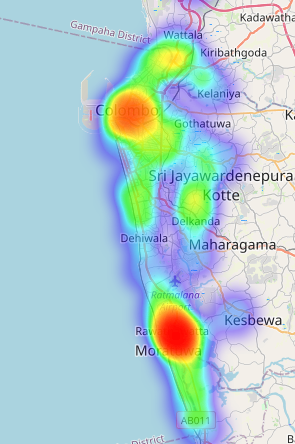
The most prominent cluster of Anglican churches is found along the western coast, from Wattala to Moratuwa, covering Colombo, the capital. This includes the deaneries of Colombo North, Colombo South, and Moratuwa and Environs in the Diocese of Colombo. Within Colombo city itself, sub-clusters appear in areas such as Pettah/Fort and Borella. Fort, once the administrative heart of British Ceylon, housed a significant Christian population, likely contributing to the presence of large, historic churches.
Moratuwa and Environs
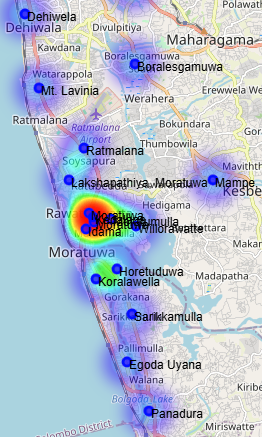
This deanery is home to landmark churches such as Holy Emmanuel Church. It is also notable for a dense concentration of churches from other denominations, such as Roman Catholic and Methodist. Interestingly, although it is a coastal town traditionally known for fishing, carpentry has also long been a prominent local profession. In contrast, the Colombo North deanery lies in a predominantly Roman Catholic area, with the Anglican community forming a smaller group.
Key Urban and Rural Clusters Outside Colombo
Kandy Cluster (Kurunegala Diocese)
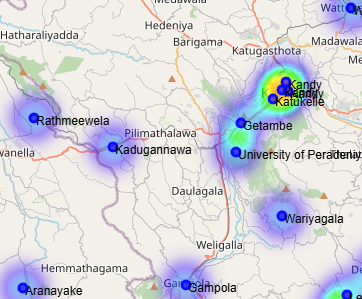
The urban area of Kandy hosts a significant Anglican presence, centred around St. Paul’s Church, one of the earliest established churches in the former Sinhala Kingdom. Trinity College, a leading Anglican school, further anchors this presence. The cluster extends to Kadugannawa, Matale, and Gampola, capturing a rich legacy of Anglican educational and ecclesiastical institutions.
Hewadiwela Cluster (Kurunegala Diocese)
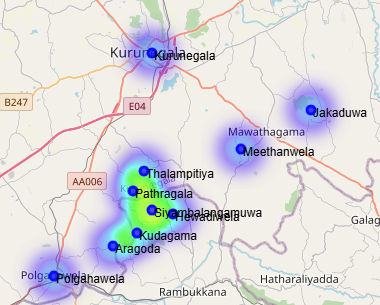
A dense and interesting rural cluster centres around St. Peter and Paul’s Church in Hewadiwela. Nearby villages such as Thalampitiya, Kudagama, Siyambalangamuwa, Aragoda, and Meethanwala host strong Anglican communities. Hewadiwela was a focal point for early CMS missionary activity, including two schools. Notably, the missionary Evelyn Carney was active in this area. This cluster continues westward to Polgahawela and Mawathagama, forming a rural Anglican belt distinct from the more urban Kurunegala town, where Anglican presence is lighter.
Hill Country Plantation Belt

The British colonial administration introduced a Tamil Church Mission to minister to estate workers brought from India. As British planters and officers also settled in the region, they soon recognised the need for a common place to worship. In the early days, prayer meetings and services were held in coffee stores, schools, and centrally located bungalows. These hill-country churches are now spread across both dioceses and cluster in the following key plantation regions:
Delthota - Pussellawa
Nawalapitiya - Ginigathhena - Watawala
Thalawakele - Hatton - Maskeliya
Kotmale - Pundaluoya
Bogawantalawa
Bandarawela - Diyatalawa
These areas remain home to active Tamil Anglican communities and historic churches shaped by plantation-era missions.
Missionary Societies and Their Regional Footprints
Different arms of the Anglican mission focused on distinct regions during British Ceylon.
The Church Missionary Society (CMS) concentrated heavily on central and western regions, establishing major schools and churches in Kandy, Colombo, Moratuwa, and Kurunegala.
The Tamil Church Mission, operating with CMS support, worked mainly in the Hill Country plantation areas, serving Tamil estate workers.
The Society for the Propagation of the Gospel (SPG) played a supporting role, especially in clergy formation and education initiatives.
This layered missionary structure helped shape the distribution patterns we see today.
Coastal Port Towns
Jaffna and the Tamil Christian Heritage
While Jaffna today is more prominently associated with Roman Catholicism, it was also an early mission field for the Church Missionary Society (CMS), beginning in the early 19th century. The CMS founded St. John’s College, Jaffna, in 1823, which became one of the leading educational institutions in the north. Although Anglican church numbers remain modest in the region today, the historic presence is significant, particularly in the spheres of education, language translation, and early evangelism among Tamil-speaking communities.
Southern and Eastern Province Missions
Coastal cities like Galle, Trincomalee and Batticaloa served as strategic Anglican mission centres due to British military and administrative presence. Historical churches like St. Mary’s in Trincomalee trace their roots to chaplaincies for colonial garrisons. Later, CMS schools were established, serving both Tamil and Sinhala communities. These areas reflect the Anglican Church’s navigation of multi-ethnic and multi-religious settings in the East and South.
Post-Independence Urban and Rural Mission Growth
Following independence, there was a subtle expansion of Anglican congregations into emerging suburbs of Colombo and other urban centres. Churches and mission points in Maharagama, Piliyandala, and Gampaha areas reflect continued community-building in growing population hubs, even though the tempo of missionary expansion was slower than in colonial times.
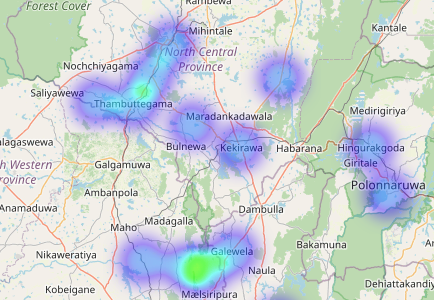
The Diocese of Kurunegala extended missionary outreach through the Wanni Mission and house church initiatives. This effort established small communities in the rural parts of the North Western and North Central provinces, forming a distinct network of Anglican presence in the hinterland.
Demographic Shifts and Legacy
Some historically strong Anglican regions—such as Hewadiwela and its satellite villages—still maintain vibrant congregations, though urban migration has changed the demographics in parts of Kurunegala, Kandy, and Colombo. Understanding these shifts helps identify both legacy areas and zones needing renewed pastoral or mission focus today.
Broader Reflections
Several discussion points emerge:
How do the distributions of Roman Catholic and Anglican churches differ across regions?
Are newer Pentecostal or evangelical churches targeting the same areas as traditional Anglican communities?
What role do early CMS schools and historical mission patterns play in sustaining Anglican identity today?
While the Church of Ceylon remains the most established Protestant denomination in Sri Lanka, these patterns reveal both its colonial roots and its ongoing relevance in a changing religious and social landscape.

